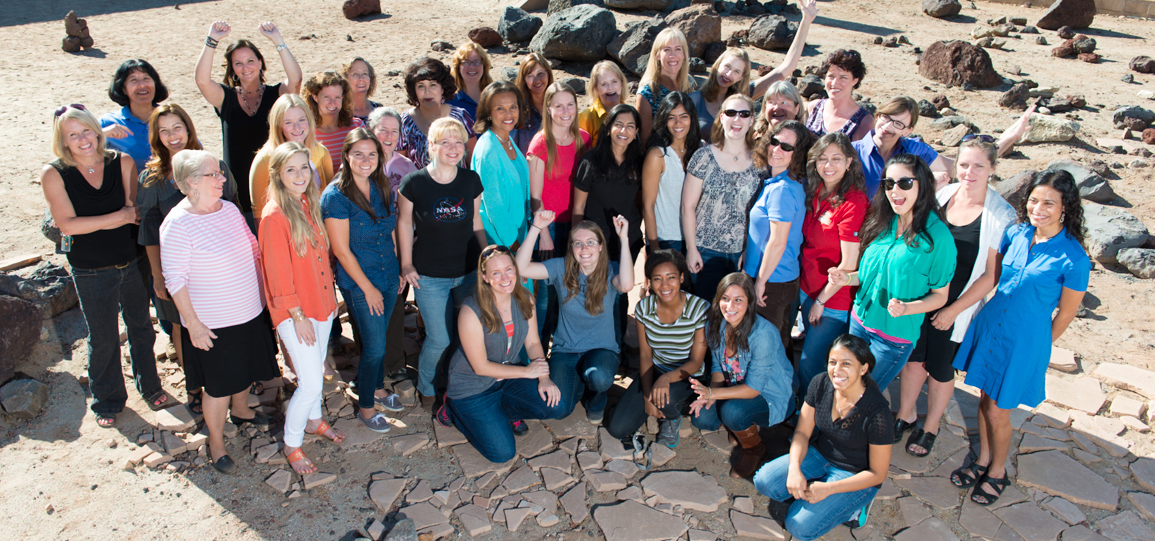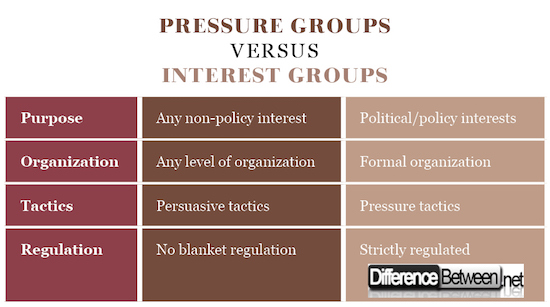Differences between Pressure Groups and Interest Groups
Interest Groups
Interest groups are large category of organizations that are formed to promote a special interest. Interest groups technically include pressure groups, and the general public is usually most familiar with the lobbying sector of pressure/interest groups. However, interest groups can be separated from pressure groups as organizations that are concerned with an interest other than coercively influencing policy.

Pressure Groups
Pressure groups are a specific sector within interest groups. These organizations use persistent and coercive techniques to affect policy and influence policymakers. Pressure groups are always political in nature and are generally advocacy or lobbying firms or organizations.

Differences between Pressure Groups and Interest Groups
Purpose
1. Interest groups :
Interest groups are groups formed by people who have some sort of common interest. This common interest can be anything from intramural sports to policy. Most people are familiar with interest groups as political lobbying organizations, but they do not have to be related to politics.
2. Pressure groups :
Pressure groups are also interest groups, but they are specifically created to address political or policy issues. Where interest groups may just want to promote their interest within their group or their greater community, pressure groups are formed to put “pressure” on policymakers or government agencies to adopt policy within the pressure group’s interest.
Organization
1. Interest groups :
Interest groups have varying levels and types of organization. However, interest groups usually have some sort of formal organization – a hierarchy or at least designated roles. Since interest groups are often nonprofits or businesses revenue or financials, some formal structure is required by law.
2. Pressure groups:
Pressure groups are formally and strictly organized. They often function as companies or are structured as nonprofits. Because they are essentially lobbying firms, pressure groups usually have a firm corporate hierarchy. Since the decision in the Citizens United Supreme Court case, some corporations now function similarly to pressure groups because the regulations regarding corporate donations have changed.
Tactics
1. Interest groups :
Because interest group is a broad category, interest groups can use a wide variety of tactics to promote their ideas. They most commonly use rhetorical or emotional persuasive techniques that are less forceful and manipulative than pressure tactics. Interest groups may use money as a bargaining chip, but not in an explicitly political situation.
2. Pressure groups:
Pressure groups are so named for using pressure tactics. Pressure tactics often apply to sales and refer to persistent and coercive pressuring to accept an offer. Within the business world as a whole, pressure tactics have a bad reputation for the inclusion of illegal techniques like blackmail and bribery. However, since the activities of pressure groups are strictly monitored, they should not be relying on the illegal types of pressure tactics. Instead they may use pressure tactics like constant communication, information dumping and incessant talking during meetings, advertising and promotion, and fundraisers and donations. Pressure groups typically contact policymakers or businesses persistently until they convince or coerce a policymaker into accepting the group’s position.
Regulation
1. Interest groups:
In the U.S., Interest groups that are unrelated to politics and lobbying do not have to be specially regulated by the federal government. A large football interest group that does not donate to parties or policymakers, and that also does not partake in lobbying activities, would not have to register with the government. However, interest groups that lobby and fundraise are regulated.
2. Pressure groups:
Pressure groups by nature require federal regulation. Because pressure groups attempt to influence policy, their activities and communications with policymakers are strictly regulated. There are regulations that prohibit relationships between a policymaker and the spouse of a lobbyist, as well as strict limitations on gift-giving and paying for the travel or food of policymakers (among other activities). The financials of pressure groups are also monitored by the government; pressure groups are required to disclose most of their monetary activities that are related to politics, and are sometimes limited in how much they can fundraise and donate to party candidates.
Summary of Pressure Groups vs. Interest Groups
Interest groups and pressure groups are very similar, and in reality there is no true distinction between them – pressure groups are merely a subcategory of interest groups. However the practical differences between them are important.
- Interest groups may form around any imaginable interest. When the interest is political, the interest group is usually designated as a pressure group.
- Interest groups usually have some formal organization to deal with communications and monetary issues. Pressure groups are nearly always strictly formalized.
- Pressure groups are always regulated to make sure they comply with laws concerning fund raising, donations, and contact with the government. Interest groups include the pressure group/lobbying regulations, but nonpolitical interest groups are not especially regulated.
- Interest groups depend on persuasion and advertising to promote their interests. Pressure groups pressure policymakers with money and coercive rhetoric to influence policy.
Comparison table for Pressure Groups vs. Interest Groups

- Differences Between Google Fi and T-Mobile - August 18, 2019
- Differences Between LED Bulbs and LED Fixtures - June 1, 2019
- Differences Between McAfee and Kaspersky - April 22, 2019
Search DifferenceBetween.net :
1 Comment
Leave a Response
References :
[0]Saheb D. “Difference between Interest Groups and Pressure Groups Explained!” Share Your Essays. http://www.shareyouressays.com/knowledge/difference-between-interest-groups-and-pressure-groups-explained/112489.
[1]Jayarajan. “Pressure Group and Interest Group.” Public Administration Scholars. April 8, 2013. http://pubadscholars.blogspot.com/2013/04/pressure-group-and-interest-group.html
[2]“High Pressure Tactics.” Beasley Allen Law Firm. http://www.beasleyallen.com/practice/consumer-protection/deceptive-trade-practices/high-pressure-tactics/.
[3]“Interest Groups: How are they regulated?” United States Government course, Lumen Learning. https://courses.lumenlearning.com/americangovernment/chapter/free-speech-and-the-regulation-of-interest-groups/.
[4]Image credit: https://www.pexels.com/photo/group-of-people-in-dress-suits-776615/
[5]Image credit: http://www.jpl.nasa.gov/images/msl/20140626/womenworkingonmsl-full.jpg

so ideally pressure groups or interest groups are those groups of interest that promoted their interest in order to pursued a goals and objective.